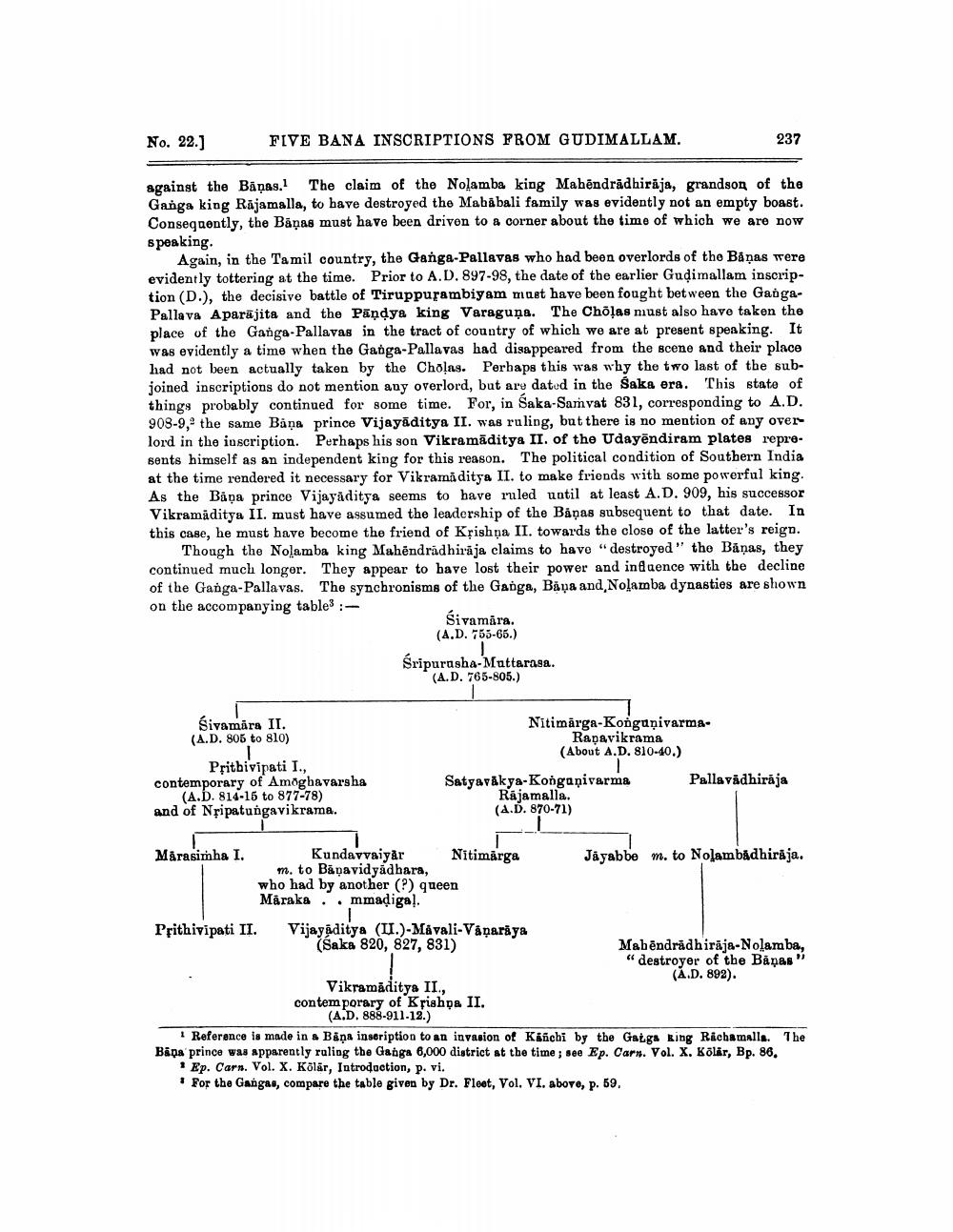________________
No. 22.]
FIVE BANA INSCRIPTIONS PROM GUDIMALLAM.
237
against the Baņas. The claim of the Nolamba king Mahendrädbirāja, grandson of the Ganga king Rajamalla, to have destroyed the Mababali family was evidently not an empty boast. Consequently, the Baņas must have been driven to a corner about the time of which we are now speaking
Again, in the Tamil country, the Ganga-Pallavas who had been overlords of the Båņas were evidently tottering at the time. Prior to A.D. 897-98, the date of the earlier Gudimallam inscription (D.), the decisive battle of Tiruppurambiyam must have been fought between the GaðgaPallava Aparajita and the Pandya king Varaguņa. The Cholas nust also have taken the place of the Ganga Pallavas in the tract of country of which we are at present speaking. It Was evidently a time when the Ganga-Pallavas had disappeared from the scene and their place had not been actually taken by the Cholas. Perhaps this was why the two last of the subjoined inscriptions do not mention any overlord, but are dated in the Saka era. This state of things probably continued for some time. For, in Saka-Samvat 831, corresponding to A.D. 903-9, the same Bana prince Vijayāditya II. was ruling, but there is no mention of any over lord in the inscription. Perhaps his son Vikramāditya II. of the Udayêndiram plates repre. sents himself as an independent king for this reason. The political condition of Southern India at the time rendered it necessary for Vikramaditya II. to make friends with some powerful king. As the Bina prince Vijayaditya seems to have ruled until at least A.D. 909, his successor Vikramaditya II. must have assumed the leadership of the Baņas subsequent to that date. In this case, he must have become the friend of Krishṇa II. towards the close of the latter's reign.
Though the Nolamba king Mahendradhiraja claims to have "destroyed" the Båņas, they continued much longer. They appear to have lost their power and influence with the decline of the Ganga-Pallavas. The synchronisms of the Ganga, Båụa and Nolamba dynasties are shown on the accompanying tables :
Sivamára. (A.D. 155-65.)
Sripurasha-Muttarasa.
(A.D. 765-805.)
Śivamára II. (A.D. 805 to 810)
Nitimärga-Konguņivarma
Rapavikrama (About A.D. 810-40.)
Pallavädhiraja
Prithivipati I., contemporary of Amoghavarsha
(A.D. 814-15 to 877-78) and of Nřipatungavikrama.
Satyavákya-Konganivarma
Rajamalla. (4.D. 870-71)
Mårasimha I. Kundavvaiyar Nitimárga Jāyabbe m. to Nolambadhiraja.
m. to Båņavidyadhara, who had by another (?) queen
Märaka .. mmadiga!. Prithivipati II. Vijayaditya (II.)-Mávali-Vanaraya (Saka 820, 827, 831)
Mabendradhiraja-Nolamba, " destroyer of the Bānas"
(A.D. 892). Vikramaditya II., contemporary of Kfishpa II.
(A.D. 888-911-12.) 1 Reference is made in a Båna inseription to an invasion of Kinebi by the Gatga Ring Richamalle. The Bana prince was apparently ruling the Ganga 6,000 district at the time ; 50 Ep. Carn. Vol. X. Kõlar, Bp. 86.
1 Ep. Cars. Vol. X. Kõlar, Introduction, p. vi.
For the Gangas, compare the table given by Dr. Flest, Vol. VI. above, p. 59.




